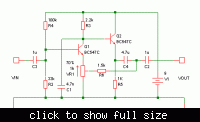neazoi
Advanced Member level 6
This little amplifier http://www.studyvilla.com/feedback.aspx gives me an idea of making a small positive feedback amplifier using a single transistor.
I have not seen any such audio amplifier on the web, aren't they used for autio? have you got any schematic sources?
I have only found this http://talkingelectronics.com/projects/HearingAid-2/images/HearingAid-1v5.gif Does it use positive global feedback? (I guess yes)
I have not seen any such audio amplifier on the web, aren't they used for autio? have you got any schematic sources?
I have only found this http://talkingelectronics.com/projects/HearingAid-2/images/HearingAid-1v5.gif Does it use positive global feedback? (I guess yes)

